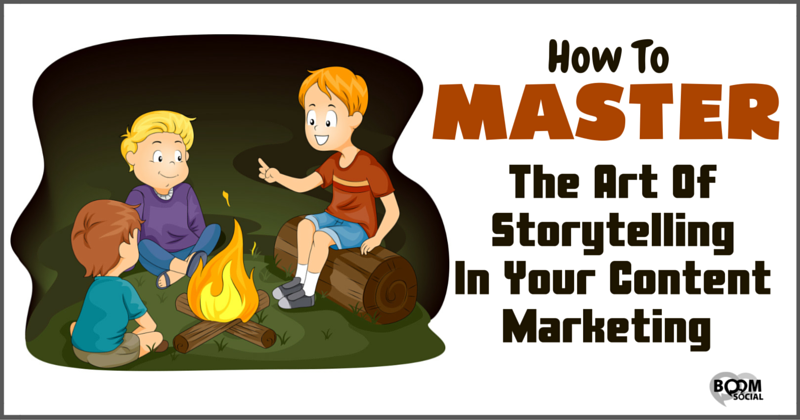Think of the last story that captivated you. Were you interested in the characters? Did you find yourself relating to the protagonist? Did you follow her as she went through a crisis, hoping she'd make it out okay in the end? And when the crisis was finally behind her, did a part of you rejoice?
That's the power of good storytelling. It's not only found in novels and memoirs. You can find it in case studies, white papers, articles, sales letters, email sequences, and other types of content. In short, storytelling should play – an important role in your content marketing strategy. It helps your audience relate to what you do and how you can help them. And it does so in a way that humans have related to each other for thousands of years.
Today, we're going to take close look at the art of storytelling, and talk about how you can use it in the content you create for your business. In order to tell a great story, you have to know what goes into one. So, let's start there.
What Makes A Great Story?
All great stories take the reader through several stages. There's a main character. Think of her as the hero of your tale. She's the one who is going to endure the most throughout the story's dramatic arc.
Next, we need some background on the hero and the setting in which she finds herself. The technical term for this stuff is exposition.
We also need rising action. Several things need to happen that push the story toward its climax.
The climax is where the big stuff happens. Big decisions are made. Big actions are taken. Big consequences are at stake.
Next is falling action. The hero goes through events that may turn out well or poorly for her. The outcomes of the events are unknown.
Lastly, a great story has to have some sort of resolution. The hero needs to resolve whatever conflict she's going through.
With those details under your belt, let's take a look at ways to use storytelling in your content marketing.
Talk About A Resolved Conflict In Your Past
Here, you tell a story about how your product or service helped you to resolve a major conflict in your own life. The reader will relate to your conflict and see it as her own.
For example, suppose you sell accounting software for small businesses. You might describe how your life was a nightmare each tax season as you tried to locate old receipts, gather the right documents, and ensure every deduction was itemized and accounted for. You could go on to explain how the conflict was making your life miserable… until you stumbled on a way to solve your problem.
That's when you introduce your software, and describe how it changed everything for the better.
You're walking the reader through her own story. The frustration you once dealt with is the same frustration she's currently going through. When you present the solution (your software), she'll be more inclined to buy it.
Explain How An Expert Changed Your Life
This approach is built around a story in which an expert helped you to resolve your conflict. It's a type of personal narrative, but it focuses on how the expert's insight changed your life. The point of the story is to get the reader to understand that you are now passing along the insight you learned from the expert to her.
For example, let's say you sell vitamins and health supplements. You could explain how you were always tired and lethargic until you met a health guru who changed everything. The health expert pointed you to a special blend of vitamins that doubled your energy and made you feel like a new person.
At the end of the story, explain that you are now passing along the insight you learned from the health guru to your customers. Assuming they are dealing with the same problems you described going through yourself, they'll be more willing to trust and buy from you.
Telling The Story Of Your Brand
Another way to use storytelling in your content is to weave a story around your brand. What conflict led you to start your business? How did you come up with the business principles and philosophy your brand represents?
Your story might focus on charitable work you've performed in the past. It may include details about your family's history. It might involve your lifelong commitment to a trait you learned as a child.
Regardless of the brand story you tell, the protagonist – or main character – should be your customer. She's the one you're in business to help. She's the one who drives you to do better. In your story, the reader will identify herself as the hero. And when she realizes how you can help her to resolve her main conflict, she'll start looking at your products and services.
And in the end, that's what content marketing is all about.
Your Turn!
Have you tried to weave a personal story into your articles, blog posts, and other content? If so, did you find that your readers and customers were able to relate to it? Share your experiences with us in the comments section!

About Author
Kim Garst
Kim Garst is a renowned marketing strategist and speaker who is trailblazing the use of artificial intelligence in digital marketing. With over 30 years of experience as an online entrepreneur, Kim helps entrepreneurs grow their business and authority online by using AI technology. She is leading the way with proven AI frameworks that help entrepreneurs build authority in their space.
She is keynote speaker and an international best-selling author of Will The Real You Please Stand Up, Show Up, Be Authentic and Prosper in Social Media.
Named by Forbes as a Top 10 Social Media Power Influencer, Kim is well-known for her skill to simplify complex technology and make the use of AI understandable for business growth. Her relatable, actionable advice helps guide new entrepreneurs to harness the power of AI to succeed in digital marketing. Kim is leading the way in combining human and technological skills to create a new model for AI-powered marketing.





Great post, thank you Kim! In this super competitive world, your company needs a certain something to stand out. Knowing the background of a company, or why they made certain decisions, gives you and extra edge and allows you to connect with a customer on another level rather than just retailer and customer (in my opinion anyway!)
Makes sense. I often sell by story. By that I mean that I typically spin a yarn…truthfully of course…of a customer with a similar situation that I have been able to help to a new prospect. It’s a gentle way to show that I understand their business and challenges and provides some credibility that I can solve the problem.
Excellent point, Harold!
Storytelling is such a huge part of good content. I agree we get caught up in being ‘professional’ sometimes when the story is what showcases great marketing!
I love the article, very informative. I am still a little confused on where you use stories in your marketing campaign. My company sells cocktail mixes and I am not sure how to use stories in my marketing. Any help would be greatly appreciated. Thanks
Mike, I would use the stories of the parties/gathering where your mixes are used… just giving the facts of your mixes are not going to make people want to go out and buy them but when you say how fun the party is that the mixes were used at makes people want to get their friends together. Hope that helps!
Thanks for dropping in, Mike and adding great value to the conversation! I am excited to see that you are moving in the storytelling direction as it is so very important! Good luck to you!
Love your suggestions, Kare! Thanks for adding value!